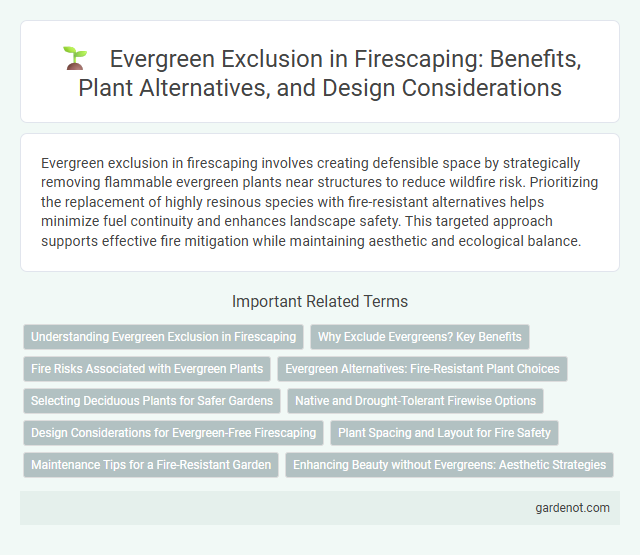Evergreen exclusion in firescaping involves creating defensible space by strategically removing flammable evergreen plants near structures to reduce wildfire risk. Prioritizing the replacement of highly resinous species with fire-resistant alternatives helps minimize fuel continuity and enhances landscape safety. This targeted approach supports effective fire mitigation while maintaining aesthetic and ecological balance.
Understanding Evergreen Exclusion in Firescaping
Evergreen exclusion in firescaping refers to the strategic removal or avoidance of fire-prone evergreen plants within landscaping designs to reduce wildfire risk. These plants often contain volatile oils and resin that can ignite easily, increasing fire spread. Understanding this concept involves selecting fire-resistant, low-flammability vegetation to create defensible spaces around properties.
Why Exclude Evergreens? Key Benefits
Excluding evergreens in firescaping reduces the risk of fire spread due to their high resin content and flammable oils, which can ignite quickly and burn intensely. Maintaining clear spaces without evergreens creates defensible zones that protect structures and increase firefighter access during wildfires. This strategic exclusion enhances overall landscape resilience and safety by prioritizing fire-resistant, low-fuel plants.
Fire Risks Associated with Evergreen Plants
Evergreen plants, while visually appealing, pose significant fire risks due to their dense foliage and high resin content that can ignite quickly and sustain flames. Their continuous year-round growth leads to the accumulation of flammable dead leaves and needles, increasing fuel load near structures. Proper firescaping involves excluding or strategically placing evergreens to reduce fire hazards and enhance defensible space.
Evergreen Alternatives: Fire-Resistant Plant Choices
Evergreen alternatives for firescaping include fire-resistant plants such as manzanita, ceanothus, and currant, which offer durability and low flammability. Opting for native species like California lilac and Oregon grape enhances fire resilience while maintaining year-round greenery. Strategic planting of these drought-tolerant evergreens can effectively reduce fire hazards without sacrificing landscape aesthetics.
Selecting Deciduous Plants for Safer Gardens
Selecting deciduous plants for safer gardens reduces fire risk because these plants shed leaves annually, minimizing dry, flammable material accumulation. Incorporating species such as maples, oaks, and birches promotes a landscape that resists wildfire spread while maintaining seasonal interest. Prioritizing deciduous flora in firescaping plans enhances garden safety by creating natural fuel breaks and improving moisture retention.
Native and Drought-Tolerant Firewise Options
Evergreen plants that are native and drought-tolerant offer excellent firewise landscaping options due to their natural resistance to ignition and ability to retain moisture. Species such as manzanita, scrub oak, and California lilac provide year-round greenery while reducing fire risk in fire-prone regions. Incorporating these native evergreens into firescaping designs promotes resilience, conserves water, and supports local ecosystems.
Design Considerations for Evergreen-Free Firescaping
Design considerations for evergreen-free firescaping emphasize selecting low-flammability, drought-tolerant plants such as native grasses, succulents, and deciduous shrubs that reduce fuel load and fire intensity. Strategically spacing vegetation to create defensible zones and incorporating hardscape elements like gravel or stone pathways enhance fire resistance. Prioritizing moisture-retentive landscaping materials and regular maintenance ensures a sustainable and safer landscape in wildfire-prone areas without evergreen species.
Plant Spacing and Layout for Fire Safety
Proper plant spacing and layout are critical in firescaping to prevent fire spread, especially when dealing with evergreen species known for their resinous foliage. Maintaining adequate distance between evergreen plants minimizes fuel continuity, reducing the risk of flames transferring from one plant to another. Incorporating fire-resistant species and ensuring open, well-maintained spaces around evergreens further enhances defensible zones and mitigates wildfire hazards.
Maintenance Tips for a Fire-Resistant Garden
Evergreen plants often require careful pruning and spacing to reduce fire risk in a firescaping design. Regularly removing dead foliage and thinning dense branches improves airflow, minimizing fuel for wildfires. Maintaining a well-irrigated, debris-free garden with fire-resistant mulch supports the longevity and safety of fire-resistant landscapes.
Enhancing Beauty without Evergreens: Aesthetic Strategies
Enhancing beauty without evergreens involves incorporating diverse plant textures, seasonal blooms, and native grasses to create dynamic, year-round interest in firescaping. Selecting drought-resistant perennials and deciduous shrubs not only adds visual appeal but also reduces fire risk by minimizing resinous foliage typical of evergreens. Strategic layering of low-flammability plants and hardscape elements ensures a fire-safe landscape that maintains aesthetic value throughout all seasons.
Evergreen exclusion Infographic

 gardenot.com
gardenot.com